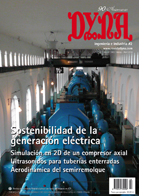A NEW NUMERICAL MODEL OF AN AXIAL COMPRESSOR TROUGH 2D SIMULATION
Keywords:
teoría de compresores en paralelo, compresor axial, distorsión del flujo de entrada, flujo cuasi-unidimensional, dinámica de fluidos computacional (CFD), parallel compressor theory, axial compressor, inlet flow distortion, quasi-one-dimensional flow, CFD.Abstract
Axial compressor modelling can be performed using 3D CFD simulations. However, this practice is very time consuming in terms of simulation design and computational execution. An alternative approach commonly used to quickly assess compressor performance is to employ models of a lower order (1D or 2D) coupled with semi-empirical models and experimental correlations. This work follows the latter philosophy and presents the results from the application of Parallel Compressor Theory (PCT) [1] to an existing model [2]. The aforementioned model, implemented in FORTRAN, numerically solves the Euler equations for a quasi-1D flow with a special treatment to account for the forces and work exchange exerted by the compressor blades. The application of PCT extends the use of the original model to conditions where the flow cannot be considered quasi-1D, e.g., inlet flow distortion or rotating stall. In addition to implementing the PCT, further improvements and modifications over the classical PCT are developed. These extensions allow a more realistic interaction between the different sub-compressors in parallel. The results obtained with this technique when simulating compressor operation under total pressure inlet flow distortion are presented. These show the capability of the model to capture the basic flow physics and trends, without incurring the high computational cost of 3D CFD. This gives confidence in the use of the presented model in the testing or industrial environments, where rapid and reliable assessment is of paramount importance.Downloads
Published
2016-03-01
Issue
Section
ARTICULOS

